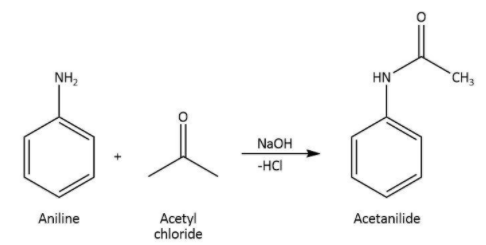
Reaction of aniline with acetyl chloride in the presence of
A) acetanilide
B) P-chloroaniline
C) a red eye
D) aniline hydrochloride
Answer
490.2k+ views
Hint: It is known that the nucleophilic reaction of the nitrogen of aromatic amines which bears a lone pair of electrons with haloalkanes and with the acid chlorides is regarded as the nucleophilic substitution reaction.
Complete answer:
Generally, we know that
We know that aniline is the primary aromatic amine. The reaction in which aniline reacts with acid chlorides, the final product of the reaction will be N-substituted amine.
Therefore, when we treat aniline with acetyl chloride in the presence of
We can write the chemical equation for the reaction carried as follows.

Hence, we can conclude that the correct option is A.
Note: It is known that the reaction of aromatic amine with aliphatic acid chloride or the aliphatic acid anhydride results in the formation of amides. The acetylation reaction is best carried out with acetic anhydride rather than acetyl chloride.
Complete answer:
Generally, we know that
We know that aniline is the primary aromatic amine. The reaction in which aniline reacts with acid chlorides, the final product of the reaction will be N-substituted amine.
Therefore, when we treat aniline with acetyl chloride in the presence of
We can write the chemical equation for the reaction carried as follows.

Hence, we can conclude that the correct option is A.
Note: It is known that the reaction of aromatic amine with aliphatic acid chloride or the aliphatic acid anhydride results in the formation of amides. The acetylation reaction is best carried out with acetic anhydride rather than acetyl chloride.
Latest Vedantu courses for you
Grade 9 | CBSE | SCHOOL | English
Vedantu 9 CBSE Pro Course - (2025-26)
School Full course for CBSE students
₹ per year
Recently Updated Pages
Master Class 12 Business Studies: Engaging Questions & Answers for Success

Master Class 12 English: Engaging Questions & Answers for Success

Master Class 12 Social Science: Engaging Questions & Answers for Success

Master Class 12 Chemistry: Engaging Questions & Answers for Success

Class 12 Question and Answer - Your Ultimate Solutions Guide

Master Class 12 Economics: Engaging Questions & Answers for Success

Trending doubts
Give 10 examples of unisexual and bisexual flowers

Draw a labelled sketch of the human eye class 12 physics CBSE

Differentiate between homogeneous and heterogeneous class 12 chemistry CBSE

Differentiate between insitu conservation and exsitu class 12 biology CBSE

What are the major means of transport Explain each class 12 social science CBSE

Franz thinks Will they make them sing in German even class 12 english CBSE




